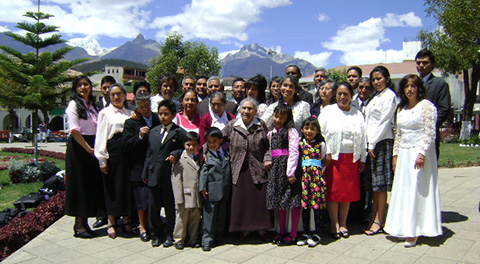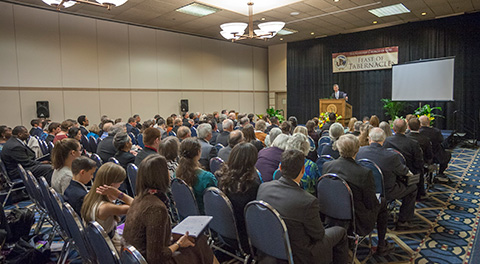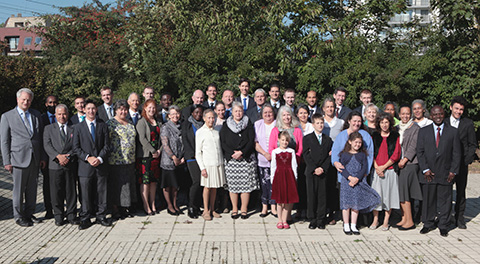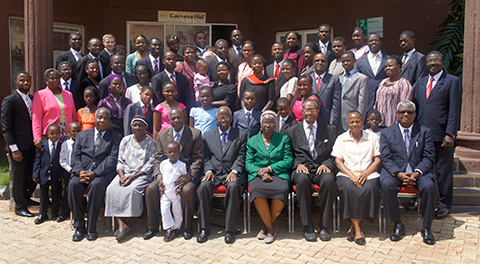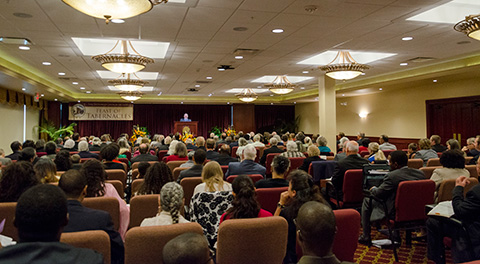Increased memory. Perseverance and a sense of achievement. Improved coordination, math, reading, listening, language and social skills. Exposure to culture and history. Better expressiveness and emotional control. Creativity, interest and passion for life.
All parents want their children to possess these qualities! There is an outlet that can help teach all of them: music.
Few things in life involve as much learning as music does. One reason is that it is both a science and an art. As a science, it requires following a challenging sequence of rules and patterns. As an art, it is a unique language that allows people to express themselves in ways words cannot.
Another reason music is unique: To excel in it requires an unrivaled level of perfection and accuracy. You can make mistakes in public speaking and sports and still recover in the end. You can make errors in writing and mathematics and make corrections. When playing an instrument or singing, however, even a handful of minor errors can ruin a performance.
Because of music’s complexity and difficulty, you may feel daunted by the prospect of teaching it to your children. This is understandable.
As with all parenting, it will take work. But there are many ways to make this manageable. First, realize that God designed music as a unique gift to humans. It allows us to express and process every emotion, from despair to joy. It can help us see beyond the physical and think spiritually.
During Sabbath services, music is the way we praise God as a group. We do it every week when we sing hymns. Yet musical praise can also be instrumental. Notice Psalm 150: “Praise Him with the sound of the trumpet: praise Him with the psaltery [lyre] and harp. Praise Him with the timbrel [tambourine] and dance: praise Him with stringed instruments and organs [reed instruments]. Praise Him upon the loud cymbals: praise Him upon the high sounding cymbals” (vs. 3-5).
How often do you think about praising God through instrumental music?
There is something we need to realize about our children. God has already started their musical training. Early in their lives, they heard the steady beat of hearts, the melodic songs of birds, the rhythms of crickets and the rattle of leaves dancing in a gentle breeze. They were exposed to all the organized sounds in Creation. These all interest and fascinate children hearing them for the first time.
God prepares children for you to further their education.
Basic Training
The baton is now in your hands to build your children’s musical legacy—to help them build crucial life skills and enjoy this gift God gives to all.
Of course, this does not mean you must send your child to a conservatory or have a music studio in your house. Yet, with all the benefits at stake, a strong case can be made that some music performing should occur in every household. Leaving it out can be as costly as skipping family dinners, household chores and yard work, playing sports, reading and other academics.
But I grew up without much musical training, you might be thinking. I’ve never considered myself a musical person, goes another excuse.
Start where you are. The key to musical training is to keep it simple, fun and meaningful.
So pop in a “Mozart Effect” tape and let Eine Kleine Nachtmusik expand your children’s minds. Right?
Well, it is not that simple.
A study from Northwestern University reported by Time magazine found that people must be actively performing a musical instrument to gain maximum benefits. It reported that “students who played instruments in class had more improved neural processing than the children who attended the music appreciation group.”
Nina Krauz, the director of Northwestern’s Auditory Neuroscience Laboratory, gave an analogy that “you’re not going to become physically fit just by watching sports.”
That said, listening is a crucial step. Just be sure to involve your children and have them learn by doing. And do not fret over your lack of ability. These activities are easy enough to learn right along with your children!
Let’s start with babies. Learn basic lullabies and sing as they go to sleep. Easy songs such as “Mary Had a Little Lamb,” “The Wheels on the Bus” and “The Itsy Bitsy Spider” work well for babies and toddlers. Even if they do not understand the words, the sound of their parents’ voices conveys comfort, and they are naturally fascinated by rhythmic patterns and tones.
Make sure to move with your baby or young child. Moving to sound reinforces rhythms that children learn. Consistent rocking motions while singing also leaves an impression on babies’ minds.
Have toys on hand, such as rattles, that produce noise as well as ones that play children’s songs.
When they become toddlers, kids can begin to interact and make music themselves. Encourage movement such as jumping, bouncing, swinging arms, twirling and dancing. They can also start to march to the beat, reinforcing the one-two movement of left, right, left, right.
A fun way for children to get excited about music is to have them make their own instruments with household items. Stretch rubber bands over a box or use paper towel rolls as trumpets. Allow them to play pretend with items from the kitchen cabinets. Upside-down pots become tom-toms, wooden spoons drumsticks, and metal lids cymbals.
Consider buying inexpensive bells, xylophones, toy drums, maracas, rhythm sticks or horns. Kazoos are another low-cost option. Encourage your children to play with them at certain times when they are happy, so they can associate making music with joy. Purchasing these instruments is not just to add noisemakers to the house. We were designed to make sound when we are joyous! Remember, God expects us to sing loudly when we are happy. Multiple psalms command people to praise Him by making “a joyful noise.”
Have music playing regularly in your house—whether streaming from the internet or playing some of your treasured cassette tapes or vinyl records. Sing along. Encourage your children to dance!
Try to incorporate a wide variety of styles, including classical, jazz, choral and folk. Your child can find meaning and interest in any or all of these styles since he or she has not developed any biases yet.
Employ call-and-response activities. This allows children to participate along with you, which emphasizes that music is for people to share. For instance, if you have toy drums, improvise a short pattern on the drum and have him or her imitate it.
All these activities aim to have your children actively listen to music as often as possible. This is more than simply having music on in the background.
For older children, have conversations about musical pieces. Ask them how it makes them feel or what images come to mind. Ask them what instruments they hear. Point out exciting elements in songs to help them visualize the sound. Or have them come up with a story for an instrumental piece.
According to PBS Kids: “Conversing about what you’re hearing not only focuses your child’s attention to the music but also suggests that music is something that elicits a response.” This also emphasizes that music is an outlet for proper godly emotions.
Formal Training
Once children reach school age, you can begin to teach basics of notation and rhythm. This can be done with flashcards or by clapping along to common rhythmic patterns. (These may be occurring in general music classes at their school.) YouTube is filled with kid-friendly videos explaining the basics of music.
As sons or daughters grow, keep exposing them to different styles. Help them develop their taste—what they like and why. Attend concerts and parades with marches. TV shows and certain movies can also provide beneficial exposure to interesting music with the added benefit of a storyline.
They could also begin to take instrument playing more seriously at this point instead of mostly just playing around with percussion.
The soprano ukulele is an excellent place to start. Guinness Book of World Records considers it the easiest instrument to learn. It can be purchased relatively inexpensively (spending at least $50 is ideal) and works well for small hands. Always research before investing in an instrument. If money is tight, an online search, such as “best budget soprano ukulele,” can help you find the best quality in your price range.
Consider learning the ukulele along with them. Teach yourself using a ukulele chord chart, or consider finding an application for a smartphone or tablet that walks you through basic skills. You could also send your child to lessons to formalize the training if desired.
If your child is doing well learning chords and strumming patterns on the ukulele, he could progress to learning guitar or other instruments.
But there is no need to rush. Some kids will not have an aptitude for learning as quickly as others. It makes little sense to push your children into formal lessons or force them to learn to read music notation before they are ready. Learning music should be a fun, positive experience for your children.
A warning here. While it is never too early to start, do not set out with the goal of turning your child into a prodigy! That will only ensure he or she either loses interest in music or becomes overly engrossed in it, resulting in an unbalanced childhood.
At the very least, keep your middle- and high-school-age children engaged in school music programs.
Ensemble playing is often the most enjoyable part of music performance. But it also teaches you things you cannot learn by playing alone.
The Scots College in Sydney, Australia, listed some of these benefits…
Social and emotional well-being: “The best memories of making music are always of making music with others, as an ensemble…By joining an ensemble, you are joining a community of musicians. You make friends, share the joy of making music together, and peer teach each other.”
Following leadership cues: “The conductor is the ensemble leader who brings all parts within a band or orchestra to work as a whole. In order for the conductor to do this, students need to learn how to interpret and respond to the conductor’s gesture and other means of communication.” Another benefit is learning to quickly and efficiently follow instructions.
Teamwork: “Playing in an ensemble allows students to develop team skills, sacrificing one’s ego to benefit the team. Whether students have the melody or harmony, students learn to listen and non-verbally communicate with each other to create music as a team. Skills learnt include learning balance, intonation, rhythm and performance etiquette in a group setting.”
Gives purpose to individual practice: “General technique is taught within one-on-one lessons but what ensemble playing can do is reinforce this technique. Even more important is that students can better understand the reason for having learned the technique thus allowing them to be more engaged and motivated to further their technique and musicianship.”
Organization: “Attending a regular rehearsal on time each week with parts learnt, as well as contributing positively to any performance involves organization on the part of the individual. Students learn the logistics of setting up their ensemble, of carting their and other instruments from A to B (for example percussion, amplifiers, double basses, stands and chairs). Students will also need to organize time to practice their individual parts so that they are contributing positively to the team.”
“As sons or daughters grow, keep exposing them to different styles. Help them develop their taste—what they like and why.”
Sometimes the fun of being in an ensemble is enough to encourage your children to commit to music. However, it can be challenging in cases where students tend to think of carrying an instrument to school as burdensome or being in choir is nerdy.
Encourage them by asking them to perform for you regularly. Attend and video-record their concerts. And reward them for their efforts! Go out for ice cream after a concert and provide feedback by saying how their practicing really paid off. If you see they are dedicated, offer to send them to private lessons to further their growth.
Also, talk about the music they make. You can have more in-depth conversations with teens. Be sure to delve into the major elements as described here.
Rhythm: The duration of notes.
Pitch: The way in which notes sound higher (such as piccolos and violins) or lower (bass, tuba) to one another.
Tempo: The speed or time between beats.
Melody: The main musical line of a piece, a combination of rhythm and pitch.
Harmony: The chords underlying the melody.
Dynamics: Loud and quiet and the change between those.
Timbre: The quality of the sound, which can be defined by the instruments being played or the style of a singer’s voice, whether dark, bright, nasally or breathy.
Form: Most songs have a common structure upon which they are built. Popular songs tend to use the following structure: verse, chorus, verse, chorus, bridge, chorus, fade-out.
Listen for these and see if you can identify and describe each. Beyond the technical points, you can discuss what composers and songwriters are conveying through their pieces.
A Complete Musical Legacy
Each person is different. While some seem born to be stars, others feel they can never carry a tune.
Indeed, some may have more interest and aptitude to become a musician, but everyone can and should be musical! Very few people are actually tone-deaf—unable to recognize changes in musical notes or reproduce them. A study put the number at only about 1.5 percent of the population.
Almost all who identify themselves as tone-deaf have really just never learned the skill of being able to match pitches. For example, a note is played on a piano, and you match it with your singing voice. This will come naturally to some; others will have to work at it.
As you work to build your child’s musical legacy, keep yourself in the picture.
By developing a love for music in your children’s heritage, they will be able to enjoy the benefits it brings—and they will always remember and appreciate you for helping them to have it in their lives.






